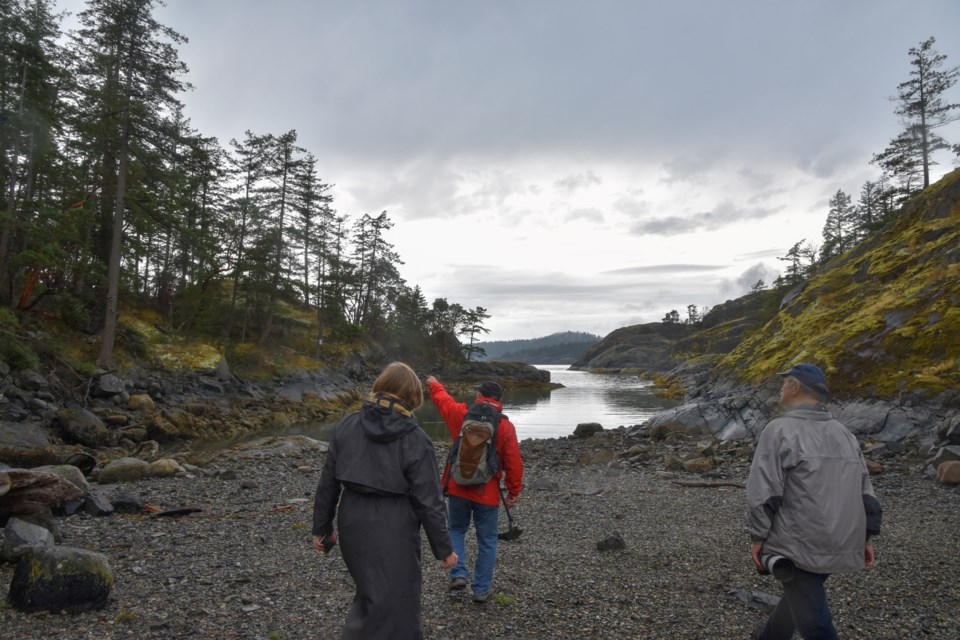For Bill Henwood, it was a “small contribution.” For the Sunshine Coast, it’s 117 acres of coastal habitat protected in perpetuity.
Last week, BC Parks Foundation announced the acquisition of more than 250 acres along Coastal B.C., almost half of which is two parcels on the Sunshine Coast.
The day of the announcement, Coast Reporter was invited to tour the newly protected lands – 32 acres near Smuggler Cove and the 85 acres of Jeddah Point – in Halfmoon Bay and to meet the former Parks Canada staffer who made it happen.
After moving to the Coast seven years ago, Henwood, an avid kayaker, would frequent Jeddah Point.
Touring the outcropping that’s home to seals, cormorants and blue herons last week, Henwood pointed out eagle nests and deer paths. The point is home to rare flowers that find unlikely purchase in the cracks along the rock base. “How the hell they survive, I don't know,” he said.
“This is a chunk of coastline that looked as if it had never been logged or touched in any way,” Henwood said in a press release. He had assumed, when he started visiting, that it was part of the nearby Smuggler Cove Provincial Park. He checked, and it was not.
It took him three years to track down the owner – a title search, a business registry search, letter writing – and finally talk to the legal executor who was getting ready to sell the site.
A call to the BC Parks Foundation confirmed that they were already aware of the site and its ecological value from neighbours. With the owner ready to sell, and with financial support from Wilson 5 Foundation and Environment and Climate Change Canada, they acquired the land.
Andrew Day, CEO of the BC Parks Foundation called the point “probably the most untouched, pristine pieces of land on the lower Sunshine Coast,” in the press release.
Having made a name for himself in conservation during both his career and retirement, Henwood was later approached by a nearby property owner, Alda Grames. She was looking for the best way to preserve the natural heritage of her land, which included the majority of Secret Cove’s undeveloped northern shoreline, according to BC Parks Foundation.
Grames has lived on the Sunshine Coast for 50 years. While on last week’s tour, she said she was “entranced” by the geography, lifestyle and nature of the Coast.
She said her property had been described as a “mosaic of microsites” and the main concept of this announcement is “protection and perpetuity of a sensitive ecosystem.”
With the help of a “generous donation” from Grames, the BC Parks Foundation acquired the 32-acre property northeast of Smuggler Cove that features more than 2,000 feet of waterfront.
North of this property lies undisturbed forest land, recognized as a retention area for marbled murrelets – which only nest in old-growth forests – and the land is known to house other species at risk, including northern red-legged frogs, great blue herons, common nighthawks, and Roosevelt elk.
Speaking to the future, Henwood said there are seven more properties in the region he is recommending the BC Parks Foundation acquire. He added many of the small islands and islets in the area are designated as crown land and will hopefully be incorporated into a larger protected space in the future.
“Protecting the environment is essential for our future. I hope the donation inspires others to do their part,” Grames said in the press release.
Other areas BC Parks Foundation announced last week as protected include a fragile island with unique geological features near Lasqueti, and waterfront forests on Vancouver and Salt Spring Islands.
The newly protected areas won’t be available for public access until use and management plans are developed through discussion with stakeholders and governments, including First Nations and other groups.
This initiative falls in line with the federal government’s 30 by 30 goal, which aims to protect 30 per cent of Canada’s land water and marine areas by 2030. “The acquisition of these properties is kind of a small contribution to that,” said Henwood.
Jordan Copp is the Coast Reporter’s civic and Indigenous affairs reporter. This reporting beat is made possible by the Local Journalism Initiative.



